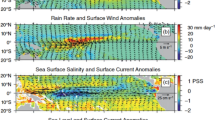Abstract
Mitigating the impacts of sea fog can be facilitated with accurate detection of sea fog events in satellite observations. While low stratus clouds and fog layers are apparent in both visible and infrared passive imager observations, some challenges remain in positively identifying cases of fog. Low liquid water clouds typically appear bright in visible imagery, but are difficult to distinguish from high clouds based only on visible reflectance. Emission from cloud tops in common infrared imagery is increasingly difficult to distinguish from surface emission as the cloud top altitude decreases. Prior work suggests that knowledge of the surface temperature can increase the reliability of satellite fog detection based on visible and infrared satellite observations. However, that work relied on output from a complex weather model. Here we exploit the co-location of sea surface temperature retrievals from passive microwave imagery with visible and infrared brightness temperature observations on the NASA Aqua polar-orbiting satellite to test a method for sea fog detection that does not rely on ancillary data from weather models or surface station data. The method exploits sea surface temperature retrievals based on microwave emission even in the presence of non-precipitating clouds. Two examples of sea fog are explored that have been verified as true cases of fog in the literature. They are found to have substantial areas of cloud where the 11 μm emission temperature of the cloud is very close to the sea surface temperature value. This differs substantially from an example of subtropical stratus and stratocumulus cloud, which has been similarly explored and found to have cloud tops substantially colder relative to the sea surface compared to the fog cases. This result suggests that the multispectral approach including microwave sea surface temperature retrievals may be able to discriminate between some types of fog and other types of low water clouds that are not fog. Application of the method is currently limited by the poor spatio-temporal sampling of polar orbiting satellites and a lack of data in the coastal zone. Validation of the method will require an independent identification of open-ocean fog cases as ground-truth. Combining the microwave sea surface temperature retrievals with geostationary visible and infrared observations may be able to overcome the sampling bias of polar-orbiting satellites, which limit views of any location to only once or twice per day. Greater than 10 years of microwave sea surface temperature retrievals allow for the possibility of constructing a global climatology of sea fog if the distinguishing features of sea fog found in this study can be validated with many more cases.
Access this chapter
Tax calculation will be finalised at checkout
Purchases are for personal use only
Similar content being viewed by others
References
Bendix, J., Thies, B., Nauss, T., & Cermak, J. (2006). A feasibility study of daytime fog and low stratus detection with TERRA/AQUA-MODIS over land. Meteorological Applications, 13, 111–125.
Chelton, D. B., & Wentz, F. J. (2005). Global microwave satellite observations of sea surface temperature for numerical weather prediction and climate research. Bulletin of the American Meteorological Society, 86, 1097–1115.
Ellrod, G. P. (1995). Advances in the detection and analysis of fog at night using GOES multi-spectral infrared imagery. Weather and Forecasting, 10, 606–619.
Gao, S., Lin, H., Shen, B., & Fu, G. (2007). A heavy sea fog event over the Yellow Sea in March 2005: Analysis and numerical modeling. Advances in Atmospheric Sciences, 24, 65–81.
Gentemann, C. L., Meissner, T., & Wentz, F. J. (2010). Accuracy of satellite sea surface temperatures at 7 and 11 GHz. IEEE Transactions on Geoscience and Remote Sensing, 48, 1009–1017.
Gultepe, I., Pagowski, M., & Reid, J. (2007). A satellite-based fog detection scheme using screen air temperature. Weather and Forecasting, 22, 444–456.
Huang, H., Liu, H., Huang, J., Mao, W., & Bi, X. (2015). Atmospheric boundary layer structure and turbulence during sea fog on the Southern China coast. Monthly Weather Review, 143, 1907–1923.
Lee, J.-R., Chung, C.-Y., & Ou, M. L. (2011). Fog detection using geostationary satellite data: Temporally continuous algorithm. Asia-Pacific Journal of Atmospheric Sciences, 47, 113–122.
Platnick, S., King, M. D., Ackerman, A., Menzel, W. P., Baum, B. A., Riédi, J. C., et al. (2003). The MODIS cloud products: Algorithms and examples from Terra. IEEE Transactions on Geoscience and Remote Sensing, 41, 459–473.
Wentz, F. J. (1997). A well-calibrated ocean algorithm for special sensor microwave/imager. Journal of Geophysical Research, 102, 8703–8718.
Wentz, F. J., & Spencer, R. W. (1998). SSM/I rain retrievals within a unified all-weather ocean algorithm. Journal of the Atmospheric Sciences, 55, 1613–1627.
Wilcox, E. M. (2012). Direct and semi-direct radiative forcing of smoke aerosols over clouds. Atmospheric Chemistry and Physics, 12, 139–149. doi:10.5194/acp-12-139-2012.
Zhang, S., & Yi, L. (2013). A comprehensive dynamic threshold algorithm for daytime sea fog retrieval over the Chinese adjacent seas. Pure and Applied Geophysics, 170, 1931–1944.
Acknowledgments
I wish to thank Darko Koračin for encouraging this work and the Desert Research Institute for support to conduct this study. AMSR-E data are produced by Remote Sensing Systems and sponsored by the NASA Earth Science REASoN DISCOVER Project and the AMSR-E Science Team. These data are available at www.remss.com. MODIS atmosphere products are distributed by the MODIS Adaptive Processing System at the NASA Goddard Space Flight Center. These data are available at ladsweb.nascom.nasa.gov. Sounding data were obtained from the University of Wyoming at weather.uwyo.edu/upperair/sounding.html.
Author information
Authors and Affiliations
Corresponding author
Editor information
Editors and Affiliations
Rights and permissions
Copyright information
© 2017 Springer International Publishing Switzerland
About this chapter
Cite this chapter
Wilcox, E.M. (2017). Multi-spectral Remote Sensing of Sea Fog with Simultaneous Passive Infrared and Microwave Sensors. In: Koračin, D., Dorman, C. (eds) Marine Fog: Challenges and Advancements in Observations, Modeling, and Forecasting. Springer Atmospheric Sciences. Springer, Cham. https://doi.org/10.1007/978-3-319-45229-6_11
Download citation
DOI: https://doi.org/10.1007/978-3-319-45229-6_11
Published:
Publisher Name: Springer, Cham
Print ISBN: 978-3-319-45227-2
Online ISBN: 978-3-319-45229-6
eBook Packages: Earth and Environmental ScienceEarth and Environmental Science (R0)




